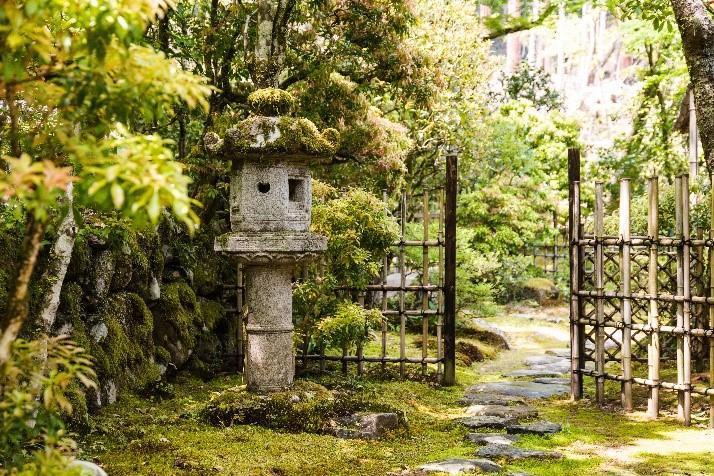Garden Knowing/
keywords
The Tea Garden

UNESCO World Heritage Site Kosan-ji Temple’s Iko-an Garden is a modern tea garden located on top of Mt. Toganoo.
The Tea Garden
“There is no Japanese garden whose objective is clearer than the tea garden.”(*1) This quote from one of the tea garden’s most authoritative interpreters perhaps epitomizes best the special place it holds in Japan’s gardening tradition. More than any other Japanese garden form, the tea garden can be said to have born from a single purpose: to provide a pathway leading to the tearoom. Yet during the sixteenth and seventeenth centuries, this seemingly simplistic goal increasingly pushed Japan’s urban tea connoisseurs to embrace the tea garden as a means of differentiating the mystical realm of tea from the hectic world of everyday life.
Indeed, while the word for “tea garden” in Japanese (roji) originally meant little more than an “alleyway,” this same word was later reinterpreted to mean “dewy ground,” a reading replete with Buddhist connotations of spiritual rebirth. What tea brought to the Japanese gardening tradition, then, was its unique concept of the garden as a process. Through its disciplined focus on enacting a transition away from the everyday world toward a purified state of mind completed before reaching the tea room, the roji based itself upon directing guests’ body movements and sensory perceptions in order to focus their spirits. The stepping stones, water basins, stone lanterns, bamboo gates and barriers so commonly associated with Japanese gardens today all bear evidence to the tea garden’s total coordination of each scenic transition with the movements of its guests.
It was by encountering tea, then, that Japanese gardens learned to integrate all five of our senses with nature. Long before the roji’s emergence, Japanese gardens had already known many ways of paying homage to nature’s beauty. Yet when Japanese commoners adapted that tradition to the needs of the tea ceremony (chanoyu), they subordinated it to the realities of their own dwellings located in crowded cities far away from natural scenery. Thus was born the tea garden ideal of a “mountain abode in the city” (shichu no sankyo) capable of designing natural scenes superior to the most remote and rustic hermitage.
Although they have long outgrown their exclusive association with tea culture, the ideal of tea gardens as “mountain abodes in the city” is still with us. Given the pace of urban development today, the tea garden’s ingenious possibilities for integrating human beings with nature are perhaps just as vital for the modern city as they are for the Japanese gardening tradition.
*1 Amasaki Hiromasa, “Sōzō suru dentō” in Nakamura Hajime, Amasaki Hiromasa, Fūkei o tsukuru (Showado, 2021) 35
